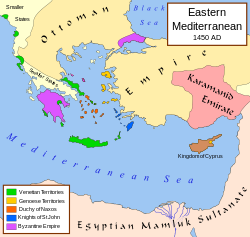Hospitaller Rhodes
Hospitaller Rhodes | |||||||||||
|---|---|---|---|---|---|---|---|---|---|---|---|
| 1310–1522 | |||||||||||
 Rhodes and other possessions of the Knights Hospitallers of St. John. | |||||||||||
| Capital | Rhodes | ||||||||||
| Religion | Roman Catholicism | ||||||||||
| Government | Elective monarchy | ||||||||||
| Governor | |||||||||||
| Historical era | Middle Ages | ||||||||||
• Hospitaller occupation of Rhodes | 1310 | ||||||||||
| 22 December 1522 | |||||||||||
| |||||||||||
| Today part of | Greece | ||||||||||
The history of Rhodes under the Order of Saint John lasted from 1310 until 1522. The island of
History
After the extinction of the Kingdom of Jerusalem with the fall of Acre in 1291, the order sought refuge in the Kingdom of Cyprus. Finding themselves becoming enmeshed in Cypriot politics, their Master, Guillaume de Villaret, created a plan of acquiring their own temporal domain, selecting Rhodes to be their new home, part of the Byzantine Empire.
Due to repeated disagreements with the

At Rhodes, the resident knights of each langue were headed by a baili. The English Grand Prior at the time was Philip De Thame, who acquired the estates allocated to the English langue from 1330 to 1358. In 1334, the Knights of Rhodes defeated Andronikos III Palaiologos and his Turkish auxiliaries. In the 14th century, there were several other battles in which they fought.[1]
In 1374, the Knights took over the defence of Smyrna, conquered by a crusade in 1344.[2] They held it until it was besieged and taken by Timur in 1402.[2]
On Rhodes the Hospitallers
In 1402, they created a stronghold on the peninsula of Halicarnassus (present Bodrum). They used pieces of the partially destroyed Mausoleum at Halicarnassus, one of the Seven Wonders of the Ancient World, to strengthen their rampart, the Petronium.[4]
In 1522, an entirely new sort of force arrived: 400 ships under the command of Sultan Suleiman the Magnificent delivered 100,000 men to the island[5] (200,000 in other sources[6]). Against this force the Knights, under Grand Master Philippe Villiers de L'Isle-Adam, had about 7,000 men-at-arms and their fortifications. The siege lasted six months, at the end of which the surviving defeated Hospitallers were allowed to withdraw to Sicily. Despite the defeat, both Christians and Muslims seem to have regarded the conduct of Phillipe Villiers de L'Isle-Adam as extremely valiant, and the Grand Master was proclaimed a Defender of the Faith by Pope Adrian VI.
Gallery
-
Inn of Auvergne
-
Inn of England
-
Inn of France on theStreet of the Knights
-
Inn of Italy
-
Inn of Provence
-
Inn of Spain
See also
Notes
- ^ Graham, J. J. (1858). Elementary History of the Progress of the Art of War. R. Bentley. p. 299.
- ^ ISBN 0-85115-845-5.
- ^ Artemi, Eirini. "Diasporic Communities in Rhodes 1350–1450".
- ^ "Castle of St Peter". Bodrum Guide. Archived from the original on 24 November 2013. Retrieved 9 August 2019.
- ISBN 9780688080938.
- .
Bibliography
- Alessio Varisco Fides et Caritas. Il Beato Gherardo de' Saxo e i 900 anni dell'Ordine di San Giovanni di Gerusalemme di Rodi e di Malta (con catalogo delle decorazioni e gradi del Sovrano Militare Ordine di Malta e dell'Ordine pro Merito Melitensi civile e militare), Arcidosso, Effigi, 2013
- Franco Baglioni, I cavalieri di Rodi, SEI, Torino 1954.
- Eric Brockman, The Two Sieges of Rhodes: The Knights of St John at War 1480-1522, Barnes & Noble 1995.
- Giulio Jacopi, Lo Spedale dei Cavalieri e il Museo Archeologico di Rodi, La Libreria dello Stato, Roma 1932.
- Elias Kollias, I Cavalieri di Rodi. Il palazzo e la città, Ekdotike Athenon S.A., Atene 1991.
- Luttrell, Anthony (1975). "The Hospitallers at Rhodes, 1306–1421". In ISBN 0-299-06670-3.
- Luttrell, Anthony (1988). "The Hospitallers of Rhodes Confront the Turks, 1306–1421". In Gallagher, P. F. (ed.). Christians, Jews, and Other Worlds: Patterns of Conflict and Accommodation. New York and London: University Press of America. pp. 80–116.
- Anthony Lutrell, The town of Rhodes 1306-1356, Rodi 2003.
- Vassilia Petzsa-Tzounakou, Rodi la città dei Cavalieri, Bonechi, Firenze 1996.
- Jean-Christian Poutiers, Rhodes et ses chevaliers, ESTC, Araya 1989.
- Stephen C Spiteri, Fortresses of the Knights, Book Distributors Ltd, 2001
- Carlo Trionfi, Il segno degli eroi. Storia dell'assedio di Rodi, Ceschina, Milano 1933.
- Paulette Tsimbouki, Rodi l'isola dei fiori, Leonti, Pireo 1963.








